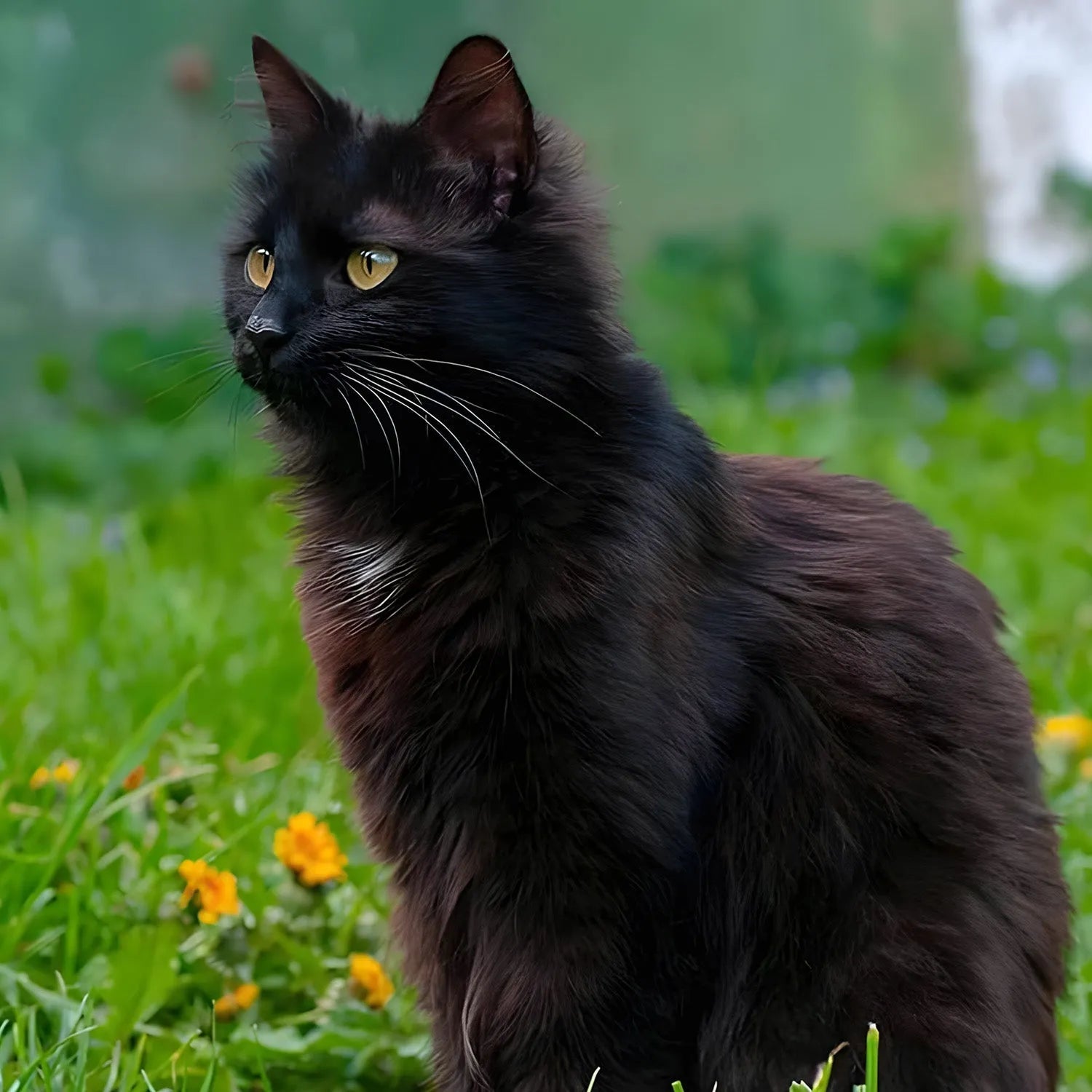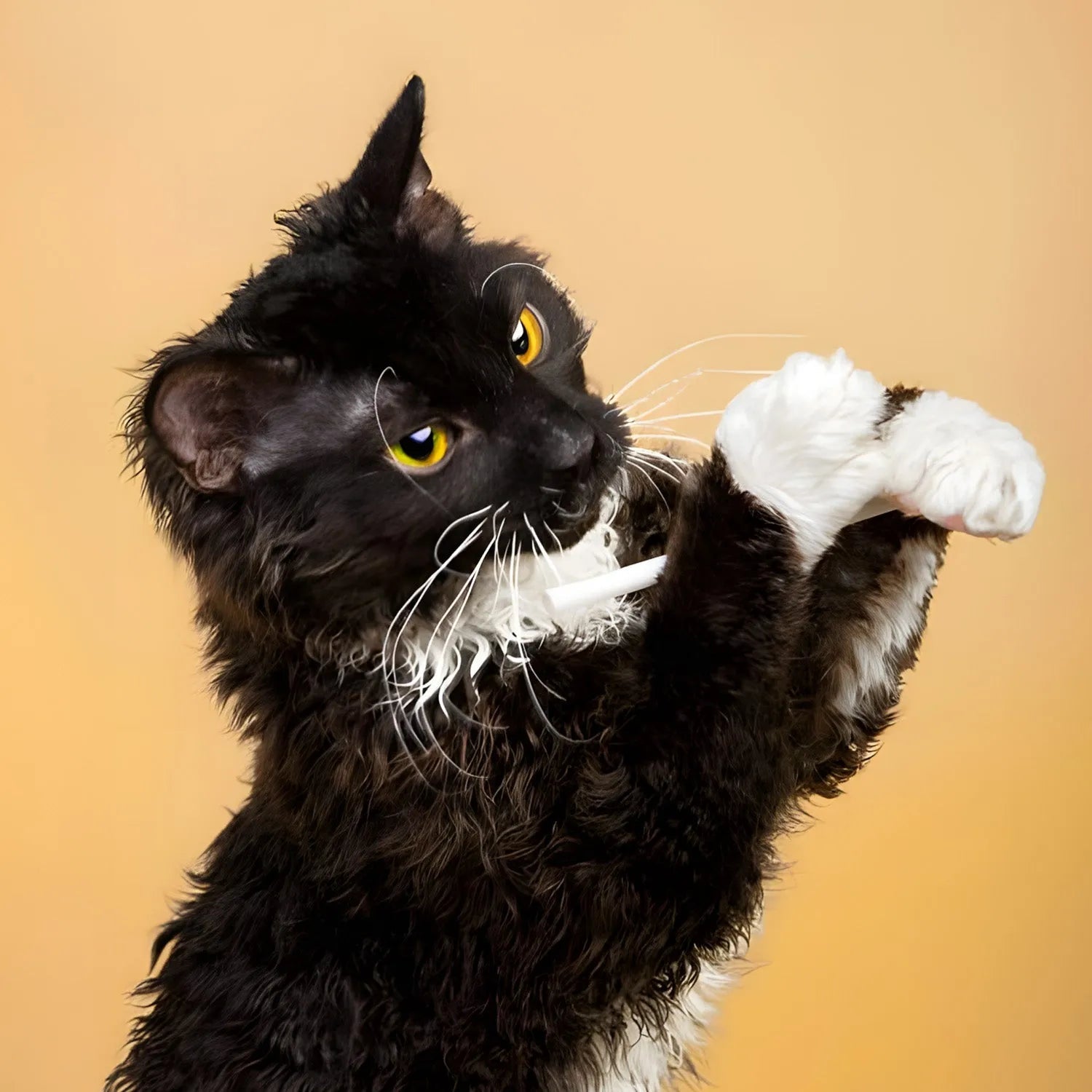Norwegian Forest Cat: The Majestic Viking Companion
Introduction
The Norwegian Forest Cat, often called "Wegie" by its fans, is a large, sturdy breed with a thick, water-resistant coat perfectly suited for the cold Scandinavian winters. With origins that trace back to Norse mythology, this majestic breed has been the companion of Vikings and farmers alike. Despite its wild appearance, the Norwegian Forest Cat is friendly, affectionate, and adapts well to family life. Known for their intelligence and playful nature, these cats make excellent companions for those who appreciate both their beauty and their independent spirit. In this blog, we’ll explore the Norwegian Forest Cat’s lifestyle, behavior, grooming needs, and how it interacts with humans and other pets.
Ratings (1-5)
-
Environmental Adaptability: 5
-
Food Consumption: 4
-
Need for Companionship: 4
-
Trainability: 4
-
Tolerance of Children: 5
-
Ease of Domestication: 4
History and Origins
The Norwegian Forest Cat has a rich history that dates back centuries. It is believed that these cats accompanied the Vikings on their voyages, helping to keep the ships free of rodents. Known in Norwegian as "Skogkatt," meaning "forest cat," these felines were highly prized by farmers in Norway for their ability to catch mice and other pests. The breed’s thick coat allowed it to survive in harsh climates, making it well-suited to the rugged Norwegian landscape. While the breed almost disappeared during World War II, efforts to revive it began in the 1970s, and it has since become popular around the world. Today, the Norwegian Forest Cat is recognized by major cat associations and is beloved for its beauty and personality.
Physical Characteristics and Colors
The Norwegian Forest Cat is a large, muscular cat with a strong, sturdy build. Its most distinctive feature is its thick, double-layered coat, which is water-resistant and designed to protect it from the cold. The coat is longer around the neck, forming a ruff, and shorter on the shoulders, with a long, bushy tail that the cat can wrap around itself for warmth. The breed has tufted ears, giving it a lynx-like appearance, and almond-shaped eyes that can come in a variety of colors, including green, gold, and blue. Norwegian Forest Cats come in a wide range of colors and patterns, including tabby, solid, bicolor, and tortoiseshell. Despite their large size, they are graceful and agile, with strong claws that allow them to climb trees with ease.
Lifestyle and Behavior
Norwegian Forest Cats are known for their friendly, playful, and independent personalities. While they enjoy human companionship, they are not overly clingy and are happy to entertain themselves when left alone. These cats are natural explorers and climbers, often enjoying the highest spots in the house. They have a curious nature and love to investigate their surroundings, making them well-suited to homes with plenty of space and opportunities for exploration. Despite their independence, Norwegian Forest Cats are affectionate and enjoy spending time with their families. They are known for their gentle nature and are often described as "dog-like" in their loyalty to their owners. These cats are also quite vocal and will often communicate with soft chirps and meows.
Trainability and Intelligence
Norwegian Forest Cats are intelligent cats that can be trained to follow basic commands, perform tricks, and even walk on a leash. They respond well to positive reinforcement techniques, such as treats and praise, and enjoy interactive toys that challenge their minds. Because of their playful nature, Norwegian Forest Cats enjoy games that involve problem-solving, such as puzzle feeders or hide-and-seek with toys. Training sessions with Norwegian Forest Cats should be engaging and fun, as they have a natural curiosity and love to learn new things. Their intelligence, combined with their independent streak, makes them easy to train and a joy to interact with.
Social Behavior and Human Interaction
Norwegian Forest Cats are social cats that form strong bonds with their human families. While they are independent and enjoy spending time on their own, they are also affectionate and will seek out attention from their owners when they want to cuddle or play. These cats are known for their gentle and friendly nature, making them excellent companions for individuals or families who want a loving but not overly demanding pet. Norwegian Forest Cats are happiest in homes where they can receive plenty of love and companionship, but they are also content to entertain themselves when left alone. They are vocal cats that enjoy "talking" to their owners, using a variety of chirps and meows to communicate.
Compatibility with Children and Other Pets
Norwegian Forest Cats are excellent companions for children due to their gentle and patient nature. They enjoy interactive play and are generally tolerant of children’s antics, provided they are treated with respect. Their playful nature makes them ideal playmates for kids, and they often enjoy chasing toys or climbing cat trees with their human companions. Additionally, Norwegian Forest Cats tend to get along well with other pets, including dogs, as long as they are properly introduced. Their sociable and adaptable nature allows them to integrate well into multi-pet households, and they often enjoy the company of other animals as much as they do humans.
Grooming and Care
The grooming needs of a Norwegian Forest Cat are moderate due to its thick, double-layered coat. Regular brushing—at least two to three times a week—is essential to prevent tangles and mats from forming, especially around the neck, belly, and underarms. During shedding season, more frequent brushing may be necessary to manage the loose fur. Norwegian Forest Cats do not require regular baths, as their coats are naturally water-resistant, but occasional baths may be needed if the cat gets particularly dirty. Regular dental care, ear cleaning, and nail trimming are also important to maintain their overall health. Despite their grooming needs, Norwegian Forest Cats enjoy the bonding time that grooming sessions provide, and it can be a great way to strengthen the bond between cat and owner.
Health and Lifespan
Norwegian Forest Cats are generally healthy, but like all breeds, they can be prone to certain genetic conditions. One of the most common issues associated with the breed is hypertrophic cardiomyopathy (HCM), a form of heart disease. Responsible breeders screen for this condition to reduce its prevalence. Regular veterinary check-ups and a balanced diet are essential to maintain their health. With proper care, Norwegian Forest Cats can live up to 12-16 years or more. Regular monitoring and preventive care are important to ensure a long and healthy life for your Norwegian Forest Cat.
Environmental Adaptability
Norwegian Forest Cats are highly adaptable cats that can thrive in various living environments, whether in a small apartment or a larger home. They are particularly well-suited to indoor living, where they can enjoy a stimulating environment with plenty of interactive play. Because of their thick coat, Norwegian Forest Cats are more comfortable in cooler climates, but they can adapt to warmer temperatures if they have access to cool, shaded areas. Their love of climbing means they appreciate having cat trees, shelves, or other high places to explore and perch. Their adaptable nature makes them well-suited to a wide range of living conditions, but they thrive best in homes where they can be active and receive plenty of attention and mental stimulation.
Feeding Requirements
A balanced diet is crucial for maintaining the Norwegian Forest Cat's health and energy levels. High-quality cat food that is rich in protein is recommended. Fresh water should always be available. Because Norwegian Forest Cats are large and active, they may require more calories than smaller breeds to support their energy levels. Consult your veterinarian for specific dietary recommendations based on your cat's age, weight, and health needs. Monitoring their diet to prevent obesity is important, as Norwegian Forest Cats can be prone to overeating if not properly managed.
Conclusion
The Norwegian Forest Cat is a majestic, intelligent breed that brings beauty, companionship, and adventure to any household. Their strong bonds with their human companions, combined with their playful and independent nature, make them wonderful pets for families and individuals alike. If you're looking for a cat that will form a deep, loving connection with you and provide years of companionship, the Norwegian Forest Cat might be the perfect fit for you.
For more information about other cat breeds and pet care tips, stay tuned to our blog!
References:
-
Thompson, L. (2021). "The Majestic Norwegian Forest Cat." *Journal of Feline Studies*, 35(3), 215-230.
-
Richards, A. (2020). "Caring for Your Norwegian Forest Cat: A Comprehensive Guide." *Cat Lover’s Magazine*, July issue, pp. 25-33.
-
Harris, E. (2019). "Health and Wellness in Norwegian Forest Cats." *Veterinary Journal*, 79(2), 123-137.


